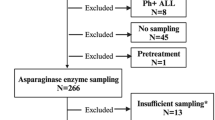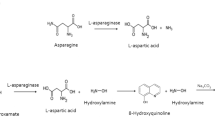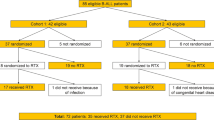Abstract
Asparaginase is an effective antileukemic agent and is included in most front-line protocols for pediatric acute lymphoblastic leukemia (ALL) worldwide; however, allergic reactions to asparaginase may be dose-limiting. We evaluated plasma anti-asparaginase antibody concentrations in a cohort of children with newly diagnosed ALL, who did and who did not exhibit clinical hypersensitivity, after Escherichia coli (E. coli) asparaginase therapy. Thirty-five children who received asparaginase 10 000 IU/m2 i.m. three times weekly for nine doses as part of both multiagent induction and reinduction chemotherapy, and seven monthly doses during the first 7 months of continuation treatment, were studied. Twenty-two patients experienced initial allergic reactions to asparaginase during continuation (n = 20) or reinduction (n = 2) phases and 13 children did not exhibit any reaction. An enzyme-linked immunosorbent assay (ELISA) was used to measure anti-asparaginase antibodies in plasma samples, diluted 1:3200, using E. coli asparaginase as the antigen. The median anti-asparaginase antibody concentration (OD at 1:3200 dilution) increased from 0.039 at induction to 0.506 at reinduction in patients who exhibited clinical hypersensitivity (P = 0.0002). By comparison, median antibody level increased from 0.011 to 0.032 OD at identical time points in patients who did not react to asparaginase (P = 0.02). Both post-induction and post-reinduction anti-asparaginase antibody levels were higher in reacting than in nonreacting patients (P = 0.004 and P = 0.01, respectively). Antibody levels were inversely related to the time elapsed between the reaction and sampling (P = 0.011). Although anti-asparaginase antibody levels increased from the post-induction plasma sample to the post-reinduction sample in 28 of 35 patients regardless of whether they exhibited clinical hypersensitivity, patients with hypersensitivity reactions had higher antibody levels than did identically treated control patients at comparable time points in therapy. Therefore, antibody analysis may be of clinical value in predicting future hypersensitivity.
This is a preview of subscription content, access via your institution
Access options
Subscribe to this journal
Receive 12 print issues and online access
$259.00 per year
only $21.58 per issue
Buy this article
- Purchase on Springer Link
- Instant access to full article PDF
Prices may be subject to local taxes which are calculated during checkout
Similar content being viewed by others
Author information
Authors and Affiliations
Rights and permissions
About this article
Cite this article
Woo, M., Hak, L., Storm, M. et al. Anti-asparaginase antibodies following E. coli asparaginase therapy in pediatric acute lymphoblastic leukemia. Leukemia 12, 1527–1533 (1998). https://doi.org/10.1038/sj.leu.2401162
Received:
Accepted:
Published:
Issue Date:
DOI: https://doi.org/10.1038/sj.leu.2401162
Keywords
This article is cited by
-
Options in Hypersensitivity Reactions to Chemotherapeutics
Current Treatment Options in Allergy (2018)
-
Use of PEG-asparaginase in newly diagnosed adults with standard-risk acute lymphoblastic leukemia compared with E. coli-asparaginase: a retrospective single-center study
Scientific Reports (2016)
-
Successful challenges using native E. coli asparaginase after hypersensitivity reactions to PEGylated E. coli asparaginase
Cancer Chemotherapy and Pharmacology (2014)
-
Incidence, clinical features and management of hypersensitivity reactions to chemotherapeutic drugs in children with cancer
European Journal of Clinical Pharmacology (2013)
-
Clinical utility and implications of asparaginase antibodies in acute lymphoblastic leukemia
Leukemia (2012)



